Supply Chain Management Report: Trends, Analytics, and Strategies
VerifiedAdded on 2023/01/11
|8
|2495
|53
Report
AI Summary
This report provides a comprehensive overview of supply chain management (SCM), exploring its evolution and the impact of technological advancements. It delves into the critical role of SCM in modern business, emphasizing the importance of a strong network for timely product delivery. The report highlights the integration of supply chain analytics, using case studies of companies like FedEx and IBM to illustrate how data-driven insights improve efficiency, reduce costs, and facilitate quick decision-making. It examines various types of supply chain analytics, including descriptive, predictive, prescriptive, and cognitive, and their applications in optimizing operations. The report also discusses the four stages of the supply chain: plan, source, make, deliver, and return, detailing how analytics are employed at each stage to enhance performance and manage risks. The report concludes by emphasizing the importance of real-time data and the value of incorporating supply chain analytics to achieve operational excellence and gain a competitive advantage.
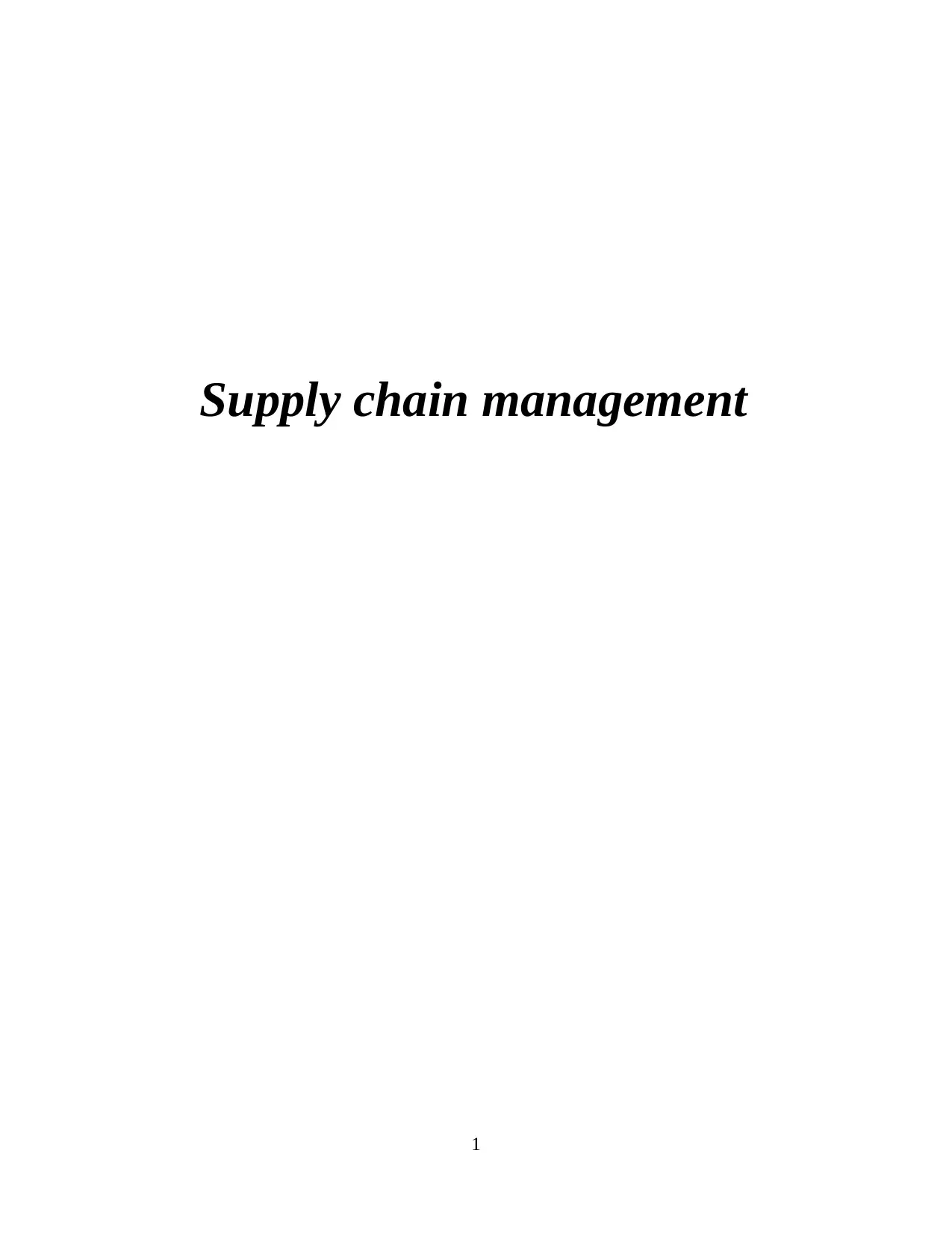
Supply chain management
1
1
Paraphrase This Document
Need a fresh take? Get an instant paraphrase of this document with our AI Paraphraser

Table of Contents
INTRODUCTION...........................................................................................................................3
PART A...........................................................................................................................................3
REFERENCES................................................................................................................................7
2
INTRODUCTION...........................................................................................................................3
PART A...........................................................................................................................................3
REFERENCES................................................................................................................................7
2
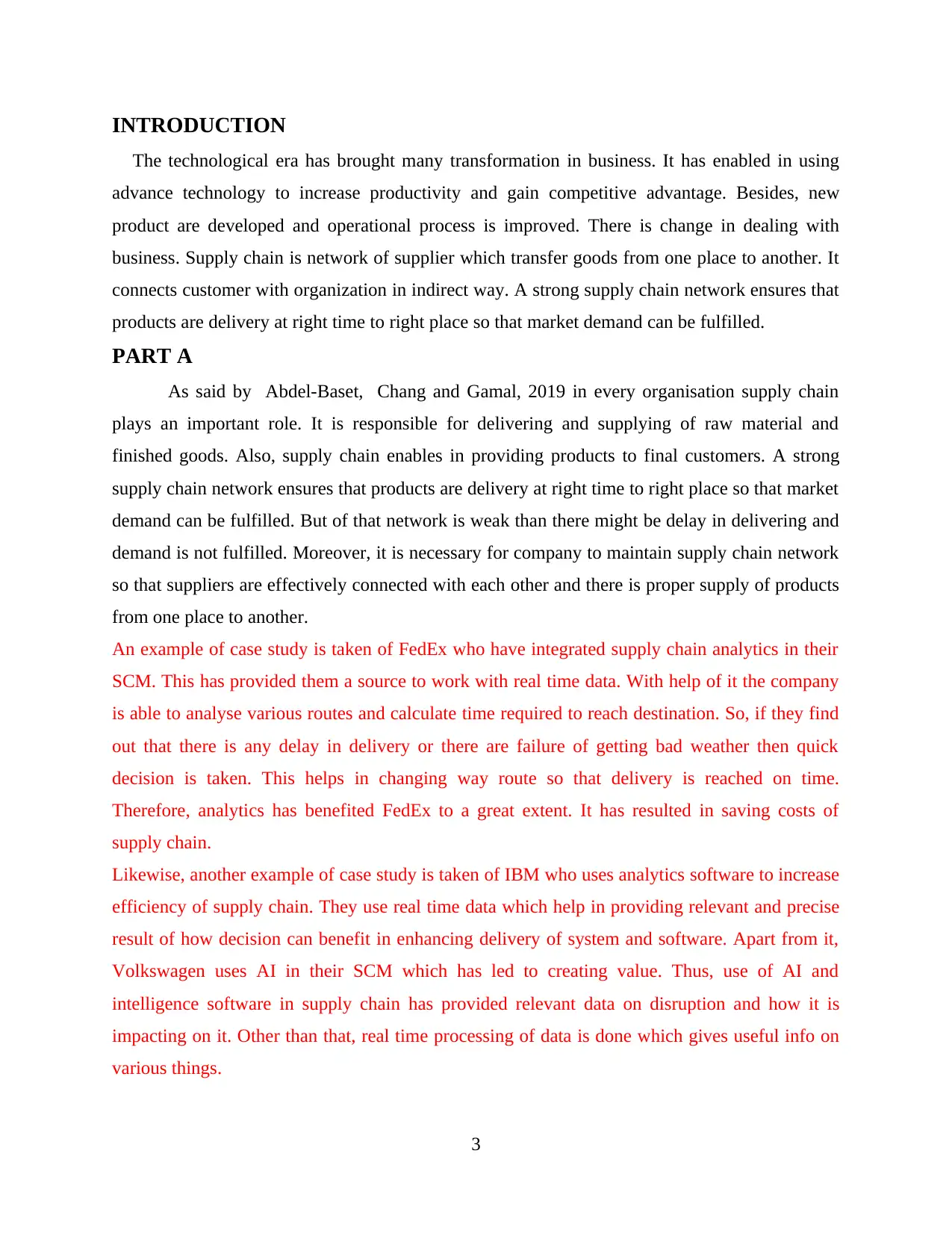
INTRODUCTION
The technological era has brought many transformation in business. It has enabled in using
advance technology to increase productivity and gain competitive advantage. Besides, new
product are developed and operational process is improved. There is change in dealing with
business. Supply chain is network of supplier which transfer goods from one place to another. It
connects customer with organization in indirect way. A strong supply chain network ensures that
products are delivery at right time to right place so that market demand can be fulfilled.
PART A
As said by Abdel-Baset, Chang and Gamal, 2019 in every organisation supply chain
plays an important role. It is responsible for delivering and supplying of raw material and
finished goods. Also, supply chain enables in providing products to final customers. A strong
supply chain network ensures that products are delivery at right time to right place so that market
demand can be fulfilled. But of that network is weak than there might be delay in delivering and
demand is not fulfilled. Moreover, it is necessary for company to maintain supply chain network
so that suppliers are effectively connected with each other and there is proper supply of products
from one place to another.
An example of case study is taken of FedEx who have integrated supply chain analytics in their
SCM. This has provided them a source to work with real time data. With help of it the company
is able to analyse various routes and calculate time required to reach destination. So, if they find
out that there is any delay in delivery or there are failure of getting bad weather then quick
decision is taken. This helps in changing way route so that delivery is reached on time.
Therefore, analytics has benefited FedEx to a great extent. It has resulted in saving costs of
supply chain.
Likewise, another example of case study is taken of IBM who uses analytics software to increase
efficiency of supply chain. They use real time data which help in providing relevant and precise
result of how decision can benefit in enhancing delivery of system and software. Apart from it,
Volkswagen uses AI in their SCM which has led to creating value. Thus, use of AI and
intelligence software in supply chain has provided relevant data on disruption and how it is
impacting on it. Other than that, real time processing of data is done which gives useful info on
various things.
3
The technological era has brought many transformation in business. It has enabled in using
advance technology to increase productivity and gain competitive advantage. Besides, new
product are developed and operational process is improved. There is change in dealing with
business. Supply chain is network of supplier which transfer goods from one place to another. It
connects customer with organization in indirect way. A strong supply chain network ensures that
products are delivery at right time to right place so that market demand can be fulfilled.
PART A
As said by Abdel-Baset, Chang and Gamal, 2019 in every organisation supply chain
plays an important role. It is responsible for delivering and supplying of raw material and
finished goods. Also, supply chain enables in providing products to final customers. A strong
supply chain network ensures that products are delivery at right time to right place so that market
demand can be fulfilled. But of that network is weak than there might be delay in delivering and
demand is not fulfilled. Moreover, it is necessary for company to maintain supply chain network
so that suppliers are effectively connected with each other and there is proper supply of products
from one place to another.
An example of case study is taken of FedEx who have integrated supply chain analytics in their
SCM. This has provided them a source to work with real time data. With help of it the company
is able to analyse various routes and calculate time required to reach destination. So, if they find
out that there is any delay in delivery or there are failure of getting bad weather then quick
decision is taken. This helps in changing way route so that delivery is reached on time.
Therefore, analytics has benefited FedEx to a great extent. It has resulted in saving costs of
supply chain.
Likewise, another example of case study is taken of IBM who uses analytics software to increase
efficiency of supply chain. They use real time data which help in providing relevant and precise
result of how decision can benefit in enhancing delivery of system and software. Apart from it,
Volkswagen uses AI in their SCM which has led to creating value. Thus, use of AI and
intelligence software in supply chain has provided relevant data on disruption and how it is
impacting on it. Other than that, real time processing of data is done which gives useful info on
various things.
3
⊘ This is a preview!⊘
Do you want full access?
Subscribe today to unlock all pages.

Trusted by 1+ million students worldwide
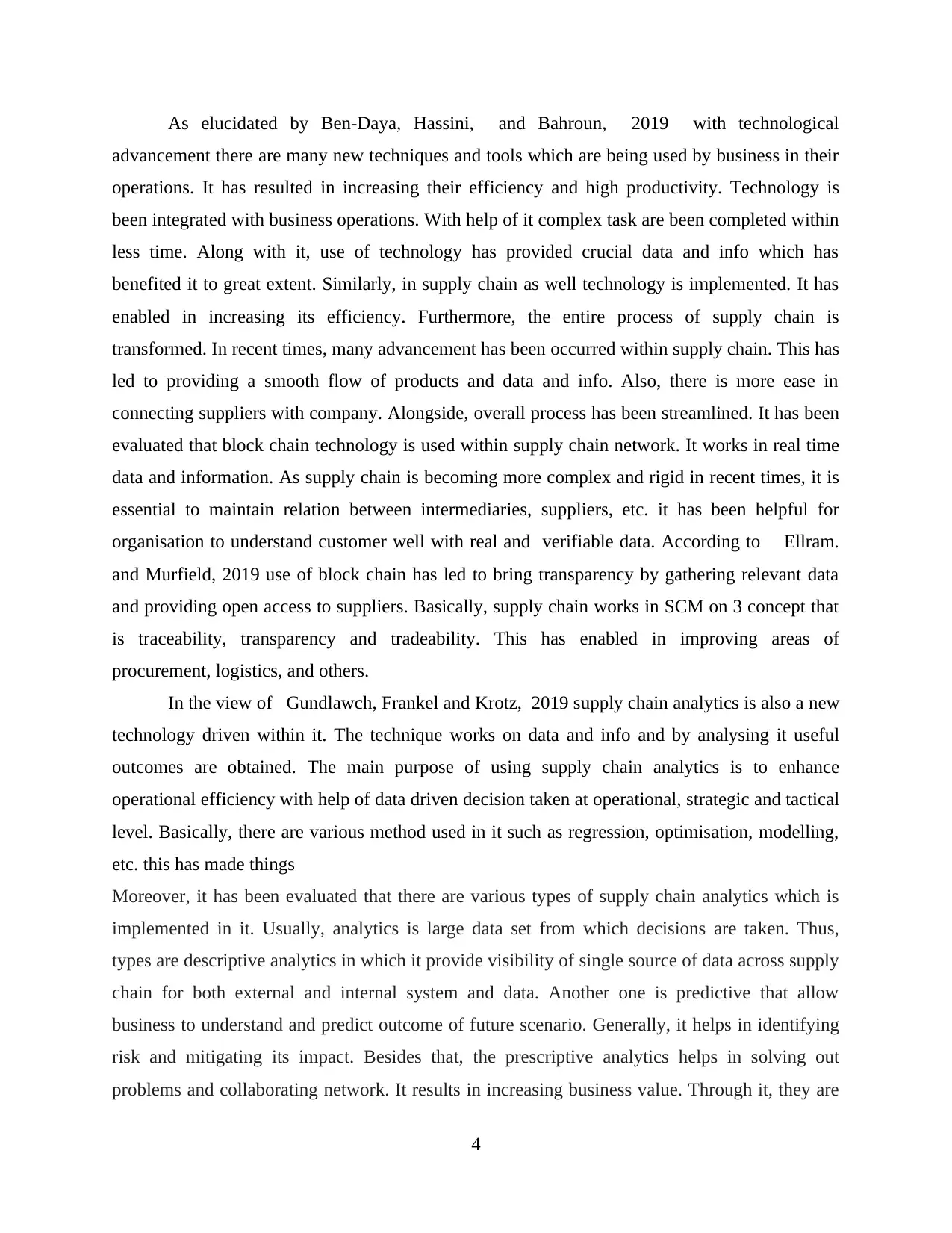
As elucidated by Ben-Daya, Hassini, and Bahroun, 2019 with technological
advancement there are many new techniques and tools which are being used by business in their
operations. It has resulted in increasing their efficiency and high productivity. Technology is
been integrated with business operations. With help of it complex task are been completed within
less time. Along with it, use of technology has provided crucial data and info which has
benefited it to great extent. Similarly, in supply chain as well technology is implemented. It has
enabled in increasing its efficiency. Furthermore, the entire process of supply chain is
transformed. In recent times, many advancement has been occurred within supply chain. This has
led to providing a smooth flow of products and data and info. Also, there is more ease in
connecting suppliers with company. Alongside, overall process has been streamlined. It has been
evaluated that block chain technology is used within supply chain network. It works in real time
data and information. As supply chain is becoming more complex and rigid in recent times, it is
essential to maintain relation between intermediaries, suppliers, etc. it has been helpful for
organisation to understand customer well with real and verifiable data. According to Ellram.
and Murfield, 2019 use of block chain has led to bring transparency by gathering relevant data
and providing open access to suppliers. Basically, supply chain works in SCM on 3 concept that
is traceability, transparency and tradeability. This has enabled in improving areas of
procurement, logistics, and others.
In the view of Gundlawch, Frankel and Krotz, 2019 supply chain analytics is also a new
technology driven within it. The technique works on data and info and by analysing it useful
outcomes are obtained. The main purpose of using supply chain analytics is to enhance
operational efficiency with help of data driven decision taken at operational, strategic and tactical
level. Basically, there are various method used in it such as regression, optimisation, modelling,
etc. this has made things
Moreover, it has been evaluated that there are various types of supply chain analytics which is
implemented in it. Usually, analytics is large data set from which decisions are taken. Thus,
types are descriptive analytics in which it provide visibility of single source of data across supply
chain for both external and internal system and data. Another one is predictive that allow
business to understand and predict outcome of future scenario. Generally, it helps in identifying
risk and mitigating its impact. Besides that, the prescriptive analytics helps in solving out
problems and collaborating network. It results in increasing business value. Through it, they are
4
advancement there are many new techniques and tools which are being used by business in their
operations. It has resulted in increasing their efficiency and high productivity. Technology is
been integrated with business operations. With help of it complex task are been completed within
less time. Along with it, use of technology has provided crucial data and info which has
benefited it to great extent. Similarly, in supply chain as well technology is implemented. It has
enabled in increasing its efficiency. Furthermore, the entire process of supply chain is
transformed. In recent times, many advancement has been occurred within supply chain. This has
led to providing a smooth flow of products and data and info. Also, there is more ease in
connecting suppliers with company. Alongside, overall process has been streamlined. It has been
evaluated that block chain technology is used within supply chain network. It works in real time
data and information. As supply chain is becoming more complex and rigid in recent times, it is
essential to maintain relation between intermediaries, suppliers, etc. it has been helpful for
organisation to understand customer well with real and verifiable data. According to Ellram.
and Murfield, 2019 use of block chain has led to bring transparency by gathering relevant data
and providing open access to suppliers. Basically, supply chain works in SCM on 3 concept that
is traceability, transparency and tradeability. This has enabled in improving areas of
procurement, logistics, and others.
In the view of Gundlawch, Frankel and Krotz, 2019 supply chain analytics is also a new
technology driven within it. The technique works on data and info and by analysing it useful
outcomes are obtained. The main purpose of using supply chain analytics is to enhance
operational efficiency with help of data driven decision taken at operational, strategic and tactical
level. Basically, there are various method used in it such as regression, optimisation, modelling,
etc. this has made things
Moreover, it has been evaluated that there are various types of supply chain analytics which is
implemented in it. Usually, analytics is large data set from which decisions are taken. Thus,
types are descriptive analytics in which it provide visibility of single source of data across supply
chain for both external and internal system and data. Another one is predictive that allow
business to understand and predict outcome of future scenario. Generally, it helps in identifying
risk and mitigating its impact. Besides that, the prescriptive analytics helps in solving out
problems and collaborating network. It results in increasing business value. Through it, they are
4
Paraphrase This Document
Need a fresh take? Get an instant paraphrase of this document with our AI Paraphraser
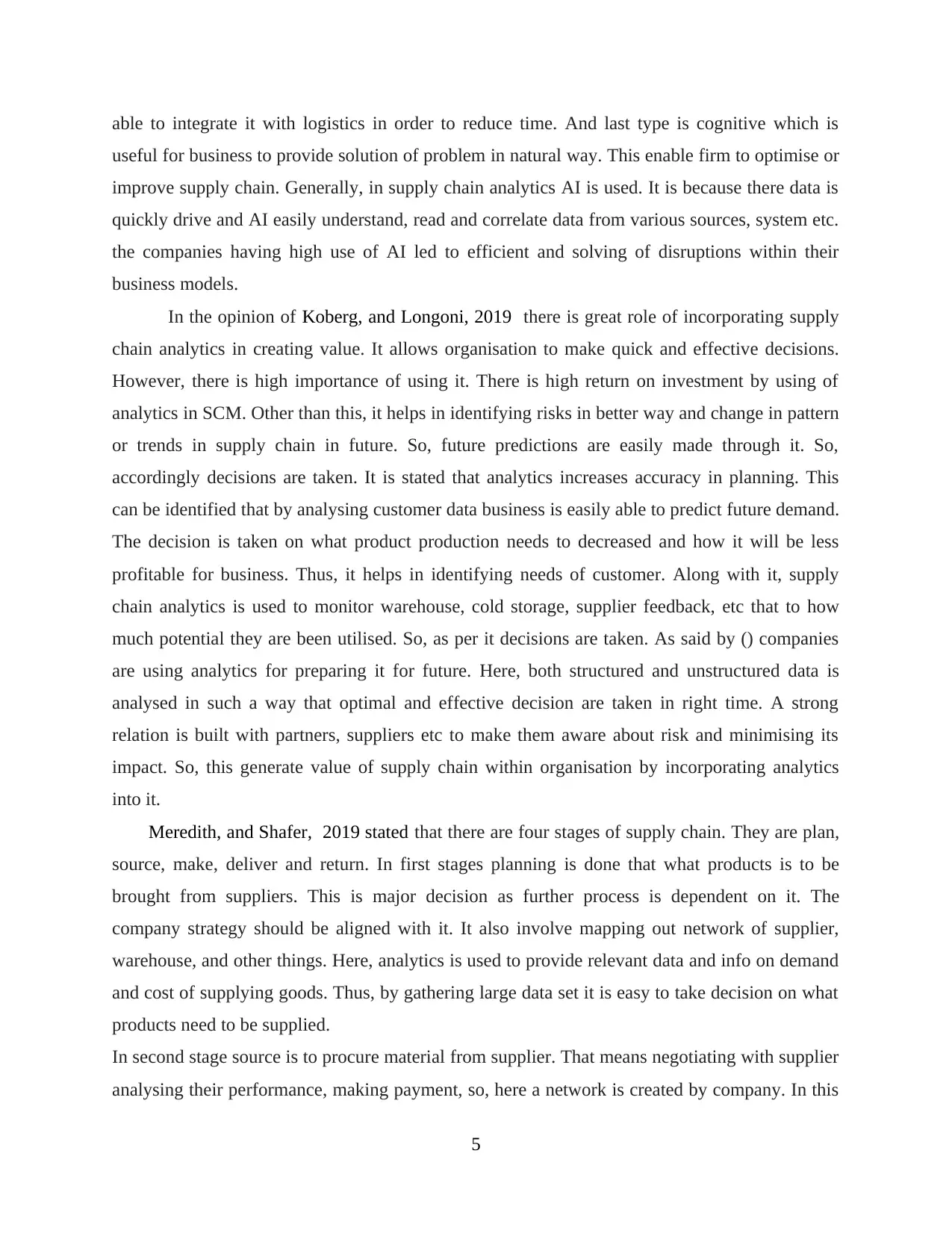
able to integrate it with logistics in order to reduce time. And last type is cognitive which is
useful for business to provide solution of problem in natural way. This enable firm to optimise or
improve supply chain. Generally, in supply chain analytics AI is used. It is because there data is
quickly drive and AI easily understand, read and correlate data from various sources, system etc.
the companies having high use of AI led to efficient and solving of disruptions within their
business models.
In the opinion of Koberg, and Longoni, 2019 there is great role of incorporating supply
chain analytics in creating value. It allows organisation to make quick and effective decisions.
However, there is high importance of using it. There is high return on investment by using of
analytics in SCM. Other than this, it helps in identifying risks in better way and change in pattern
or trends in supply chain in future. So, future predictions are easily made through it. So,
accordingly decisions are taken. It is stated that analytics increases accuracy in planning. This
can be identified that by analysing customer data business is easily able to predict future demand.
The decision is taken on what product production needs to decreased and how it will be less
profitable for business. Thus, it helps in identifying needs of customer. Along with it, supply
chain analytics is used to monitor warehouse, cold storage, supplier feedback, etc that to how
much potential they are been utilised. So, as per it decisions are taken. As said by () companies
are using analytics for preparing it for future. Here, both structured and unstructured data is
analysed in such a way that optimal and effective decision are taken in right time. A strong
relation is built with partners, suppliers etc to make them aware about risk and minimising its
impact. So, this generate value of supply chain within organisation by incorporating analytics
into it.
Meredith, and Shafer, 2019 stated that there are four stages of supply chain. They are plan,
source, make, deliver and return. In first stages planning is done that what products is to be
brought from suppliers. This is major decision as further process is dependent on it. The
company strategy should be aligned with it. It also involve mapping out network of supplier,
warehouse, and other things. Here, analytics is used to provide relevant data and info on demand
and cost of supplying goods. Thus, by gathering large data set it is easy to take decision on what
products need to be supplied.
In second stage source is to procure material from supplier. That means negotiating with supplier
analysing their performance, making payment, so, here a network is created by company. In this
5
useful for business to provide solution of problem in natural way. This enable firm to optimise or
improve supply chain. Generally, in supply chain analytics AI is used. It is because there data is
quickly drive and AI easily understand, read and correlate data from various sources, system etc.
the companies having high use of AI led to efficient and solving of disruptions within their
business models.
In the opinion of Koberg, and Longoni, 2019 there is great role of incorporating supply
chain analytics in creating value. It allows organisation to make quick and effective decisions.
However, there is high importance of using it. There is high return on investment by using of
analytics in SCM. Other than this, it helps in identifying risks in better way and change in pattern
or trends in supply chain in future. So, future predictions are easily made through it. So,
accordingly decisions are taken. It is stated that analytics increases accuracy in planning. This
can be identified that by analysing customer data business is easily able to predict future demand.
The decision is taken on what product production needs to decreased and how it will be less
profitable for business. Thus, it helps in identifying needs of customer. Along with it, supply
chain analytics is used to monitor warehouse, cold storage, supplier feedback, etc that to how
much potential they are been utilised. So, as per it decisions are taken. As said by () companies
are using analytics for preparing it for future. Here, both structured and unstructured data is
analysed in such a way that optimal and effective decision are taken in right time. A strong
relation is built with partners, suppliers etc to make them aware about risk and minimising its
impact. So, this generate value of supply chain within organisation by incorporating analytics
into it.
Meredith, and Shafer, 2019 stated that there are four stages of supply chain. They are plan,
source, make, deliver and return. In first stages planning is done that what products is to be
brought from suppliers. This is major decision as further process is dependent on it. The
company strategy should be aligned with it. It also involve mapping out network of supplier,
warehouse, and other things. Here, analytics is used to provide relevant data and info on demand
and cost of supplying goods. Thus, by gathering large data set it is easy to take decision on what
products need to be supplied.
In second stage source is to procure material from supplier. That means negotiating with supplier
analysing their performance, making payment, so, here a network is created by company. In this
5
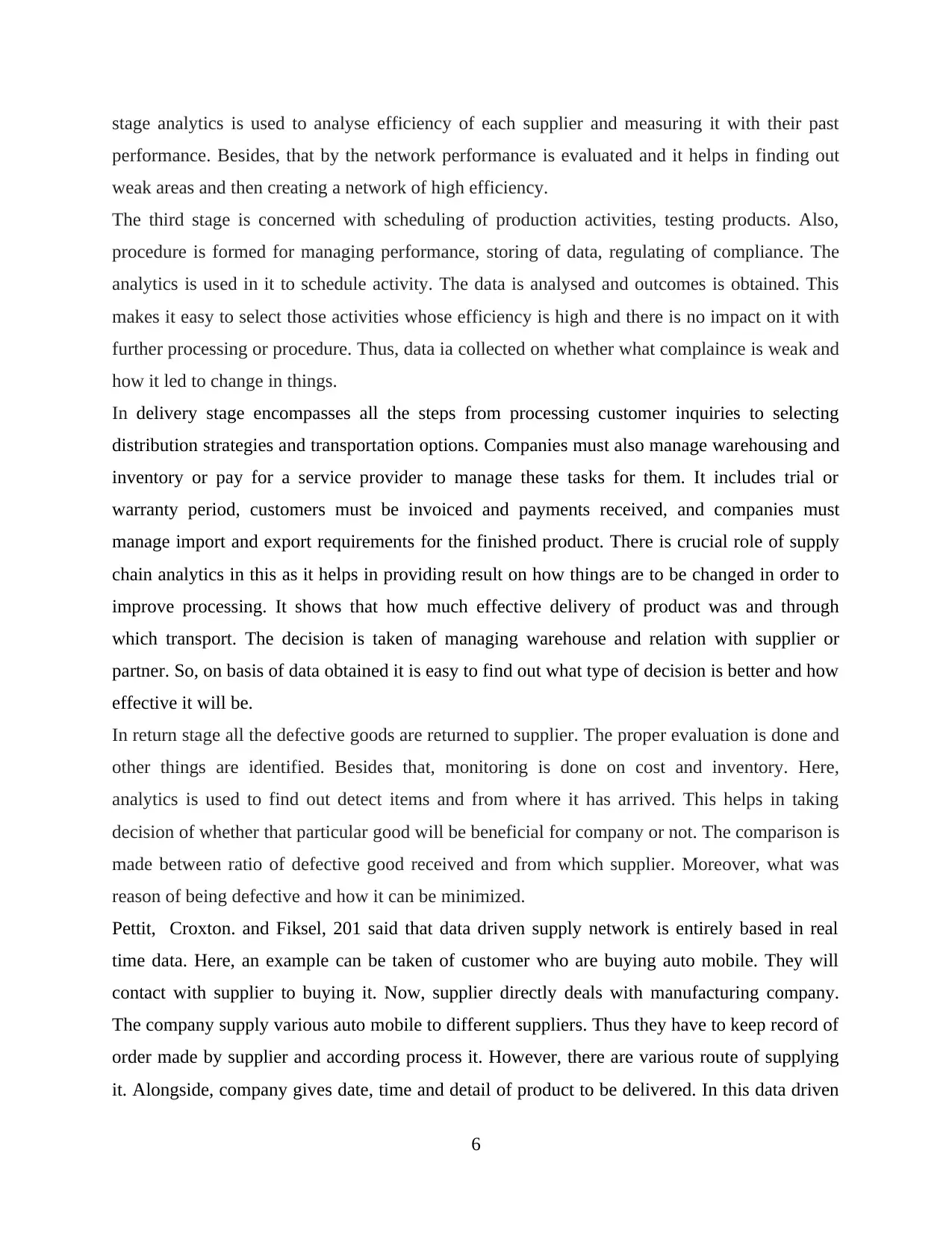
stage analytics is used to analyse efficiency of each supplier and measuring it with their past
performance. Besides, that by the network performance is evaluated and it helps in finding out
weak areas and then creating a network of high efficiency.
The third stage is concerned with scheduling of production activities, testing products. Also,
procedure is formed for managing performance, storing of data, regulating of compliance. The
analytics is used in it to schedule activity. The data is analysed and outcomes is obtained. This
makes it easy to select those activities whose efficiency is high and there is no impact on it with
further processing or procedure. Thus, data ia collected on whether what complaince is weak and
how it led to change in things.
In delivery stage encompasses all the steps from processing customer inquiries to selecting
distribution strategies and transportation options. Companies must also manage warehousing and
inventory or pay for a service provider to manage these tasks for them. It includes trial or
warranty period, customers must be invoiced and payments received, and companies must
manage import and export requirements for the finished product. There is crucial role of supply
chain analytics in this as it helps in providing result on how things are to be changed in order to
improve processing. It shows that how much effective delivery of product was and through
which transport. The decision is taken of managing warehouse and relation with supplier or
partner. So, on basis of data obtained it is easy to find out what type of decision is better and how
effective it will be.
In return stage all the defective goods are returned to supplier. The proper evaluation is done and
other things are identified. Besides that, monitoring is done on cost and inventory. Here,
analytics is used to find out detect items and from where it has arrived. This helps in taking
decision of whether that particular good will be beneficial for company or not. The comparison is
made between ratio of defective good received and from which supplier. Moreover, what was
reason of being defective and how it can be minimized.
Pettit, Croxton. and Fiksel, 201 said that data driven supply network is entirely based in real
time data. Here, an example can be taken of customer who are buying auto mobile. They will
contact with supplier to buying it. Now, supplier directly deals with manufacturing company.
The company supply various auto mobile to different suppliers. Thus they have to keep record of
order made by supplier and according process it. However, there are various route of supplying
it. Alongside, company gives date, time and detail of product to be delivered. In this data driven
6
performance. Besides, that by the network performance is evaluated and it helps in finding out
weak areas and then creating a network of high efficiency.
The third stage is concerned with scheduling of production activities, testing products. Also,
procedure is formed for managing performance, storing of data, regulating of compliance. The
analytics is used in it to schedule activity. The data is analysed and outcomes is obtained. This
makes it easy to select those activities whose efficiency is high and there is no impact on it with
further processing or procedure. Thus, data ia collected on whether what complaince is weak and
how it led to change in things.
In delivery stage encompasses all the steps from processing customer inquiries to selecting
distribution strategies and transportation options. Companies must also manage warehousing and
inventory or pay for a service provider to manage these tasks for them. It includes trial or
warranty period, customers must be invoiced and payments received, and companies must
manage import and export requirements for the finished product. There is crucial role of supply
chain analytics in this as it helps in providing result on how things are to be changed in order to
improve processing. It shows that how much effective delivery of product was and through
which transport. The decision is taken of managing warehouse and relation with supplier or
partner. So, on basis of data obtained it is easy to find out what type of decision is better and how
effective it will be.
In return stage all the defective goods are returned to supplier. The proper evaluation is done and
other things are identified. Besides that, monitoring is done on cost and inventory. Here,
analytics is used to find out detect items and from where it has arrived. This helps in taking
decision of whether that particular good will be beneficial for company or not. The comparison is
made between ratio of defective good received and from which supplier. Moreover, what was
reason of being defective and how it can be minimized.
Pettit, Croxton. and Fiksel, 201 said that data driven supply network is entirely based in real
time data. Here, an example can be taken of customer who are buying auto mobile. They will
contact with supplier to buying it. Now, supplier directly deals with manufacturing company.
The company supply various auto mobile to different suppliers. Thus they have to keep record of
order made by supplier and according process it. However, there are various route of supplying
it. Alongside, company gives date, time and detail of product to be delivered. In this data driven
6
⊘ This is a preview!⊘
Do you want full access?
Subscribe today to unlock all pages.

Trusted by 1+ million students worldwide
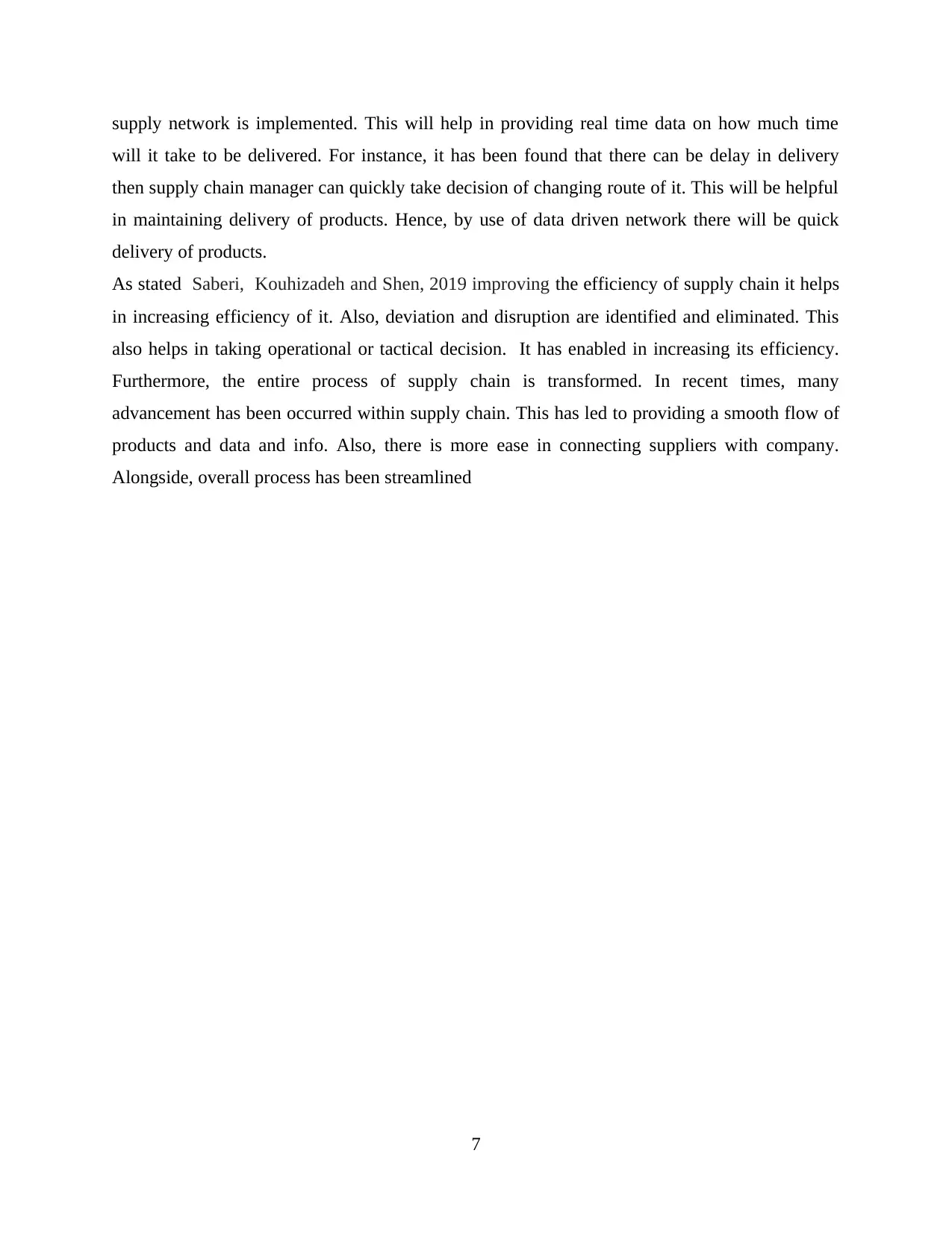
supply network is implemented. This will help in providing real time data on how much time
will it take to be delivered. For instance, it has been found that there can be delay in delivery
then supply chain manager can quickly take decision of changing route of it. This will be helpful
in maintaining delivery of products. Hence, by use of data driven network there will be quick
delivery of products.
As stated Saberi, Kouhizadeh and Shen, 2019 improving the efficiency of supply chain it helps
in increasing efficiency of it. Also, deviation and disruption are identified and eliminated. This
also helps in taking operational or tactical decision. It has enabled in increasing its efficiency.
Furthermore, the entire process of supply chain is transformed. In recent times, many
advancement has been occurred within supply chain. This has led to providing a smooth flow of
products and data and info. Also, there is more ease in connecting suppliers with company.
Alongside, overall process has been streamlined
7
will it take to be delivered. For instance, it has been found that there can be delay in delivery
then supply chain manager can quickly take decision of changing route of it. This will be helpful
in maintaining delivery of products. Hence, by use of data driven network there will be quick
delivery of products.
As stated Saberi, Kouhizadeh and Shen, 2019 improving the efficiency of supply chain it helps
in increasing efficiency of it. Also, deviation and disruption are identified and eliminated. This
also helps in taking operational or tactical decision. It has enabled in increasing its efficiency.
Furthermore, the entire process of supply chain is transformed. In recent times, many
advancement has been occurred within supply chain. This has led to providing a smooth flow of
products and data and info. Also, there is more ease in connecting suppliers with company.
Alongside, overall process has been streamlined
7
Paraphrase This Document
Need a fresh take? Get an instant paraphrase of this document with our AI Paraphraser
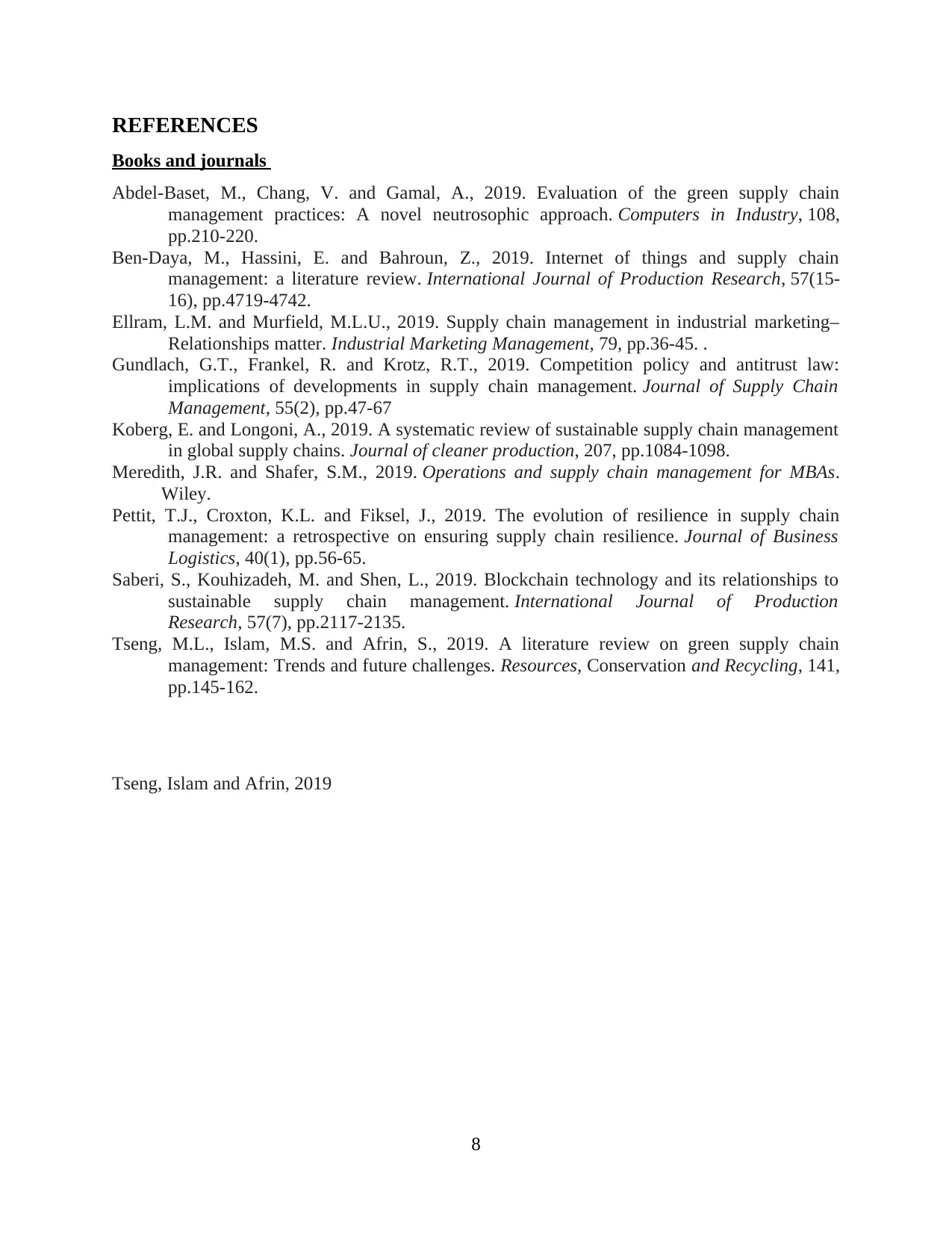
REFERENCES
Books and journals
Abdel-Baset, M., Chang, V. and Gamal, A., 2019. Evaluation of the green supply chain
management practices: A novel neutrosophic approach. Computers in Industry, 108,
pp.210-220.
Ben-Daya, M., Hassini, E. and Bahroun, Z., 2019. Internet of things and supply chain
management: a literature review. International Journal of Production Research, 57(15-
16), pp.4719-4742.
Ellram, L.M. and Murfield, M.L.U., 2019. Supply chain management in industrial marketing–
Relationships matter. Industrial Marketing Management, 79, pp.36-45. .
Gundlach, G.T., Frankel, R. and Krotz, R.T., 2019. Competition policy and antitrust law:
implications of developments in supply chain management. Journal of Supply Chain
Management, 55(2), pp.47-67
Koberg, E. and Longoni, A., 2019. A systematic review of sustainable supply chain management
in global supply chains. Journal of cleaner production, 207, pp.1084-1098.
Meredith, J.R. and Shafer, S.M., 2019. Operations and supply chain management for MBAs.
Wiley.
Pettit, T.J., Croxton, K.L. and Fiksel, J., 2019. The evolution of resilience in supply chain
management: a retrospective on ensuring supply chain resilience. Journal of Business
Logistics, 40(1), pp.56-65.
Saberi, S., Kouhizadeh, M. and Shen, L., 2019. Blockchain technology and its relationships to
sustainable supply chain management. International Journal of Production
Research, 57(7), pp.2117-2135.
Tseng, M.L., Islam, M.S. and Afrin, S., 2019. A literature review on green supply chain
management: Trends and future challenges. Resources, Conservation and Recycling, 141,
pp.145-162.
Tseng, Islam and Afrin, 2019
8
Books and journals
Abdel-Baset, M., Chang, V. and Gamal, A., 2019. Evaluation of the green supply chain
management practices: A novel neutrosophic approach. Computers in Industry, 108,
pp.210-220.
Ben-Daya, M., Hassini, E. and Bahroun, Z., 2019. Internet of things and supply chain
management: a literature review. International Journal of Production Research, 57(15-
16), pp.4719-4742.
Ellram, L.M. and Murfield, M.L.U., 2019. Supply chain management in industrial marketing–
Relationships matter. Industrial Marketing Management, 79, pp.36-45. .
Gundlach, G.T., Frankel, R. and Krotz, R.T., 2019. Competition policy and antitrust law:
implications of developments in supply chain management. Journal of Supply Chain
Management, 55(2), pp.47-67
Koberg, E. and Longoni, A., 2019. A systematic review of sustainable supply chain management
in global supply chains. Journal of cleaner production, 207, pp.1084-1098.
Meredith, J.R. and Shafer, S.M., 2019. Operations and supply chain management for MBAs.
Wiley.
Pettit, T.J., Croxton, K.L. and Fiksel, J., 2019. The evolution of resilience in supply chain
management: a retrospective on ensuring supply chain resilience. Journal of Business
Logistics, 40(1), pp.56-65.
Saberi, S., Kouhizadeh, M. and Shen, L., 2019. Blockchain technology and its relationships to
sustainable supply chain management. International Journal of Production
Research, 57(7), pp.2117-2135.
Tseng, M.L., Islam, M.S. and Afrin, S., 2019. A literature review on green supply chain
management: Trends and future challenges. Resources, Conservation and Recycling, 141,
pp.145-162.
Tseng, Islam and Afrin, 2019
8
1 out of 8
Related Documents
Your All-in-One AI-Powered Toolkit for Academic Success.
+13062052269
info@desklib.com
Available 24*7 on WhatsApp / Email
![[object Object]](/_next/static/media/star-bottom.7253800d.svg)
Unlock your academic potential
Copyright © 2020–2025 A2Z Services. All Rights Reserved. Developed and managed by ZUCOL.





